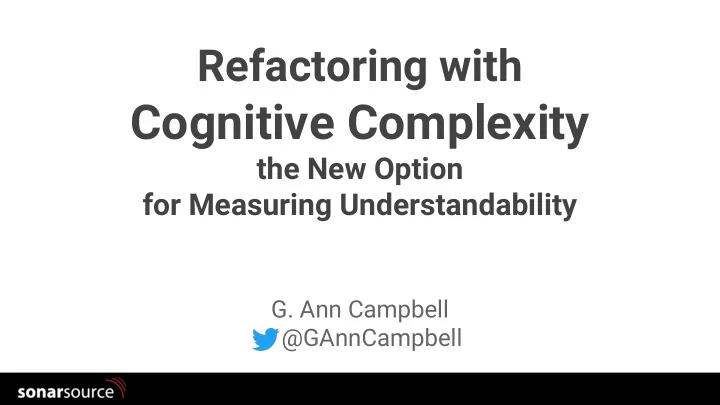

Refactoring with Cognitive Complexity the New Option for Measuring Understandability G. Ann Campbell @GAnnCampbell GenevaJug
Cognitive Complexity ● Introduced Dec. 2016 ● Available as a rule in SonarQube analyzers ○ SonarC# ○ SonarCFamily ○ SonarJava ○ SonarJS ○ … ● https://www.sonarsource.com/docs/CognitiveComplexity.pdf
Cyclomatic Complexity Intended to measure ● Testability ● Maintainability
Cyclomatic Complexity String getWords(int number) { // +1 int sumOfPrimes(int max) { // +1 int total = 0; switch (number) { OUT: for (int i = 1; i <= max; ++i) { // +1 case 1: // +1 for (int j = 2; j < i; ++j) { // +1 return "one"; if (i % j == 0) { // +1 case 2: // +1 continue OUT; return "a couple"; } case 3: // +1 } return "a few"; total += i; default: } return "lots"; return total; } } // Cyclomatic Complexity 4 } // Cyclomatic Complexity 4
Cognitive Complexity Motivations 1. Measure “understandability” 2. Incent good code
Guiding Principles
Guiding Principles 1. Ignore readable shorthand structures
Guiding Principles 1. Ignore readable shorthand structures ● Method Structure ● Null-coalescing operators
Guiding Principles 1. Ignore readable shorthand structures ● Method Structure ● Null-coalescing operators MyObj myObj = null; MyObj myObj = a?.myObj; if (a != null) { myObj = a.myObj; }
Guiding Principles 1. Ignore readable shorthand structures 2. Increment for breaks in linear flow
Guiding Principles 1. Ignore readable shorthand structures 2. Increment for breaks in linear flow if , else if , else , ternary operators ● ● switch ● catch Loops ● Sequences of logical operators ( a && b && c && d // +1 ) ● ● Jumps to labels ● Recursion
Guiding Principles 1. Ignore readable shorthand structures 2. Increment for breaks in linear flow 3. Increment for nesting
Guiding Principles 1. Ignore readable shorthand structures 2. Increment for breaks in linear flow 3. Increment for nesting Loops ● ● switch ● catch ● if and ternary
Guiding Principles 1. Ignore readable shorthand structures 2. Increment for breaks in linear flow 3. Increment for nesting Loops ● ● switch ● catch ● if and ternary else if , else increment nesting level ● ● Nested method / lambda increments nesting level
Cognitive Complexity String getWords(int number) { int sumOfPrimes(int max) { int total = 0; switch (number) { // +1 OUT: for (int i = 1; i <= max; ++i) { // +1 case 1: for (int j = 2; j < i; ++j) { // +2 return "one"; if (i % j == 0) { // +3 case 2: continue OUT; // +1 return "a couple"; } case 3: } return "a few"; total += i; default: } return "lots"; return total; } } // Cognitive Complexity 7 } // Cognitive Complexity 1
Real life code
Recap ● Cognitive Complexity: understandability ○ Increments for breaks in linear flow ○ Increments for nesting ○ Ignores readable shorthand structures ● High method Cognitive Complexity indicates a need for refactoring
Questions @GAnnCampbell
Recommend
More recommend